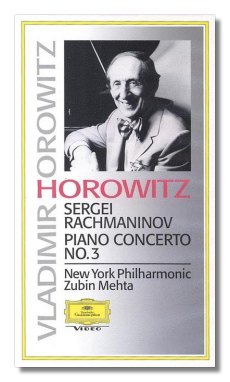
The Internet's Premier Classical Music Source
Related Links
- Rachmaninoff Reviews
- Latest Reviews
- More Reviews
-
By Composer
-
Collections
DVD & Blu-ray
Books
Concert Reviews
Articles/Interviews
Software
Audio
Search Amazon
Recommended Links
Site News
 VHS Review
VHS Review
Sergei Rachmaninoff

Piano Concerto #3 in D minor, Op. 30
Vladimir Horowitz, piano
New York Philharmonic Orchestra/Zubin Mehta
Recorded live in concert, Avery Fisher Hall, September 26, 1978
Deutsche Grammophon 440073 218-3 VHS 44:00
To celebrate the fiftieth anniversary of his American debut in 1978, Vladimir Horowitz resurrected the Rachmaninoff 3rd for his first public concerto performances in twenty five years. It was Horowitz' advocacy that established this work in the active concerto repertoire, and pianists around the world were curious as to how the seventy four year old legend would measure up to his benchmark 1930 and 1951 recordings.
Considering he hadn't played with an orchestra in years, the "official" Golden Jubilee concert recorded by RCA was understandably a high pressure event that didn't show Horowitz at his best. Subsequent performances in Los Angeles, Philadelphia and Ann Arbor, however, proved to be more assured and relaxed. So was this fifth and final one, taped at a New York Philharmonic Pension Fund benefit. True, there are vestiges of the mannered phrasings and cloying cantabiles that marred much of Horowitz' late seventies/early eighties work. There are a fair share of dropped notes and ensemble glitches, all which betray the lack of sufficient rehearsal time alluded to in the accompanying notes. Still, there is far more sense of line and continuity here with Zubin Mehta at the helm than in the RCA/Ormandy recording.
Watching Horowitz at work invariably surprises those who equate galvanizing virtuosity with flailing arms and broken strings. He sits relatively low with his fingers extending flat over the keys, taking big chords with a minimum display of movement. The pianist's complete physical economy and lack of platform mannerisms wildly contrast with the high voltage sounds emitting from his instrument. Kirk Browning's simple four camera set up is refreshingly direct and appropriate to the occasion. Unlike many of today's live concert videos, the performance is presented exactly as the audience heard it, with no post production cosmetic surgery.
The piano is unduly prominent in the mix, owing in part to the unusually bright voicing of the instrument. Out of curiosity I dug out an old reel-to-reel tape I made directly from the WQXR-FM stereo simulcast. It proved to more richly ambient and detailed than DG's mono soundtrack, with a more realistic balance between piano and orchestra. My reservations, however, are insignificant compared to the importance of DG making available this sole visual record of Vladimir Horowitz playing a concerto in public . Let's hope that the 1968 Carnegie Hall TV special and the 1978 White House recital will be forthcoming on home video soon.
(Published Piano Today May/June 1996)
Copyright © 1996, Jed Distler


















